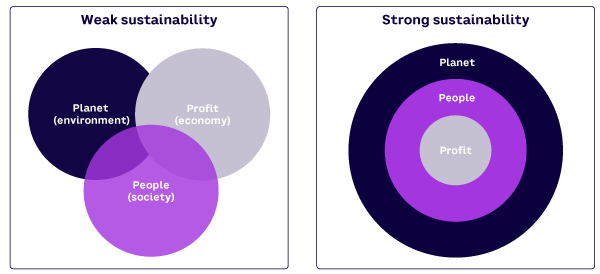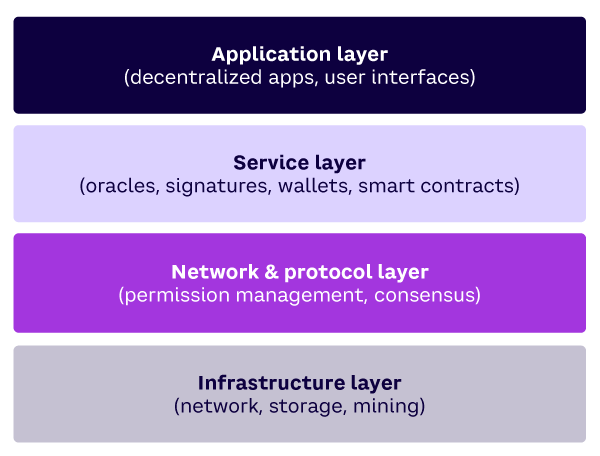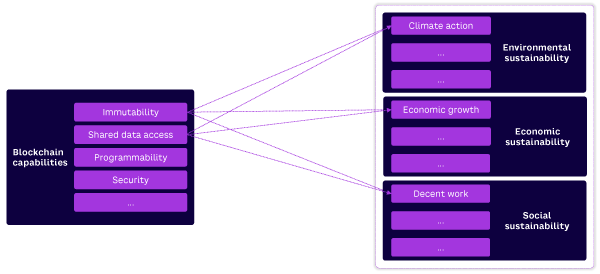AMPLIFY VOL. 36, NO. 9

Blockchain, a complex technology, and sustainability, an abstract concept, have two things in common: (1) they are fairly comprehensive and (2) vaguely defined. To understand how the former can impact the latter, core terms and existing trade-offs must be properly explained, and all positive or negative blockchain sustainability implications must be carefully evaluated. The good news is that inspiring examples exist to demonstrate how blockchain can foster positive aspects of sustainability.
Admittedly, the situation is somewhat confusing. If one goes by mainstream media, the idea that blockchains can foster sustainability is an oxymoron. A Forbes article from earlier this year is titled “Why Blockchain, NFTs, and Web3 have a Sustainability Problem,”1 implying that blockchain itself and the applications built on it pose serious problems for the environment.
Bitcoin, the foremost blockchain application, gets most of the attention. As of September 2023, the cryptocurrency uses more energy than countries like Belgium or the Phillippines.2 Several years ago, the World Economic Forum went so far as predicting that in the year 2020, Bitcoin would consume more energy than the whole earth.3 Quite foreseeably, this didn’t happen, but the current media discourse surrounding Bitcoin consistently focuses on its energy consumption, often augmented with stories about money laundering and darknets.
However, from a sustainability perspective, there is more to Bitcoin’s energy consumption than meets the eye, and the complexity of the topic increases dramatically when the focus expands to blockchain in general.4 Thus, any informed discussion of how and why blockchain technology can be relevant for sustainability must start with a careful investigation of what sustainability is and how blockchain works.
Sustainability: Weak or Strong?
In 1987, the Brundtland Commission (formerly the World Commission on Environment and Development), a suborganization of the United Nations (UN), stated that “sustainable development is development that meets the needs of the present without compromising the ability of future generations to meet their own needs.”5 In light of dwindling natural resources and the ongoing extinction of species, it is safe to say that humankind is not exactly on track.
A broad sustainability perspective includes more than the environment and natural resources. According to the concept of the “triple bottom line,” economic and societal issues should also be considered. This viewpoint is often referred to as the “three Ps”: profit, people, and the planet.
The concepts of weak and strong sustainability can be differentiated based on the relative importance of the three Ps (see Figure 1). Weak sustainability assumes the general substitutability of natural and manufactured capital such that a total capital stock is maintained, and the depletion of natural resources can be compensated for by human-made capital. Strong sustainability puts the environment first and argues that natural capital cannot be replaced. Advocates of this view argue for conservation measures, even if that means limited economic growth.6

A personal side note: from the viewpoint of thermodynamics, the strong perspective is clearly the correct one, since resources (and species) that are depleted or extinct are gone forever. Given that the total entropy (as a measure of disorder) in a closed system constantly increases, all kinds of economic activities lead to environmental degradation. These ideas were outlined in detail by ecological economist Nicholas Georgescu-Roegen back in the 1970s, so no one can say we were not warned.7
Given the lack of specificity of the general sustainability definition, in the year 2000, the UN created several actionable tasks within a comprehensive framework called the Millennium Development Goals. It proposed eight international development targets for the year 2015, with a focus on addressing the living conditions of people in developing countries. In 2015, these goals were superseded by the Sustainable Development Goals (SDGs) that include 17 objectives, which, taken together, should help achieve a more sustainable, prosperous, and equitable world by 2030.8 These goals are comprehensive and address a wide range of environmental, social, and economic challenges, some of which are arguably contradictory.
Blockchain: Not a Static Monolith
The aforementioned Forbes article nicely illustrates the problem of blockchain’s media coverage. It’s “the blockchain” that consumes energy, destroys the environment, or (less frequently) helps build innovative and useful solutions.
The truth is that “the blockchain” doesn’t exist. Instead, a wide selection of building blocks can be combined in various ways such that protocols based on distributed ledgers emerge that enable a wide range of hitherto impossible applications.
The fundament of the blockchain technology stack is the infrastructure layer in which, among other things, the rules of a decentralized network are determined, as well as the way data is stored and new coins are mined. Numerous implementation options are available for all these components. Similarly, a multitude of design choices exists for the building blocks of the subsequent layers: network and protocol layer, service layer, and application layer (see Figure 2).

This leads to a modular system in which components can be customized depending on the goals and desired features of a certain application. Importantly, no perfect solution exists, and all the different protocols have their own trade-offs between decentralization, security, and scalability. This is aptly named the “blockchain trilemma.”
Furthermore, the technologies underlying blockchain are under constant development, which renders the idea of a static technology impractical. For the sake of simplicity, in the remainder of this article I use “blockchain” as an umbrella term, but readers should be aware that the respective implementations can substantially differ.
The most interesting and controversial blockchain building block in the context of sustainability is the proof-of-work (PoW) consensus mechanism. Originally designed as an ingenious method to combat junk mail, it was cleverly applied by Satoshi Nakamoto in the Bitcoin protocol to create a network in which consensus can be reached among participants who do not need to know or trust each other.9
Such a network even works in the presence of malicious participants, as long as the majority follows the rules. To achieve this, energy is used by so-called Bitcoin miners who compete against each other in the race to create the next block of transactions on the chain, which goes along with an attractive reward that is paid out in newly created bitcoin.10
As Bitcoin’s popularity soared, incentives to spend more and more energy to compete in the race for new coins increased. The desired side effect is that the overall security of the network increases, due to the sum total of energy that goes into it. This led some to conclude that it is the PoW consensus that is causing environmental havoc, but the decisive factor is the popularity of a specific blockchain.
For example, the second most popular PoW cryptocurrency, Dogecoin, only uses a fraction of the energy that goes into Bitcoin. It is therefore PoW in combination with Bitcoin’s high appreciation that induces miners to invest in highly specialized equipment and use substantial amounts of energy to search for new blocks.
Additionally, PoW is just one option to reach consensus in a decentralized network. Alternative approaches such as proof of stake (PoS) rely on selecting validators in proportion to the amount of cryptocurrency they hold (i.e., lock up). Naturally, this approach needs much less energy, and a transition from PoW to PoS is possible, as shown by the Ethereum blockchain in September 2022. According to the Crypto Carbon Ratings Institute (CCRI), this transition reduced energy consumption by 99.988% and its carbon footprint by 99.992%.11
However, a change in the consensus mechanism has substantial implications on blockchain governance, which makes PoW and PoS hard to compare.12 In light of the overall complexity and the numerous trade-offs, how can blockchain be used to create solutions that help to address at least one of the suggested sustainability goals? I argue that a multitude of options exists by simply combining the advantageous properties of blockchain with their respective sustainability goals. The most reasonable way is to look beyond the technical details of a specific implementation and focus on the emergent capabilities instead.
Figure 3 shows examples of such capabilities, including the immutability of stored data, shared access to data in real time, programmability with the help of short self-executing programs called “smart contracts,” and increased security through encryption and clearly specified data-access roles.
These capabilities must be scrutinized to determine how they can enable and drive the respective sustainability goals, some of which are shown on the right-hand side of Figure 3. For example, the arrows illustrate how the combination of data immutability and shared data access can facilitate positive environmental, economic, and social impact via the traceability of goods (I will elaborate on this in the following section).

For illustration purposes, I have selected six potential blockchain applications with a positive impact on one (or more) sustainability goal. Although numerous projects in all these areas have already launched, I do not refer to any specific initiatives due to the fast-paced nature of industrial developments and the high likelihood that new and even more innovative projects will be launched soon. Instead, I briefly outline the underlying logic of how blockchain capabilities can have a positive sustainability impact.
Supply Chain Transparency
The immutability of transactions is a defining feature of blockchain. Access to this information is available to everyone in public blockchains (or at least to a clearly defined group of individuals or organizations in private or consortium blockchains). All authorized nodes can access the needed information in real time, and they can trust that this data has not been modified.
The combination of these features has caught the attention of supply chain professionals who strive to develop solutions that improve the traceability of goods within complex value networks. Envisioned efficiency improvements include a reduction in carbon emissions (SDG 13: Climate Action), a more efficient use of resources (SDG 8: Economic Growth), and more transparent working conditions (SDG 8: Decent Work). Accordingly, the application of blockchain in supply chain management can simultaneously contribute to several sustainability goals.
Waste Management
In a circular economy, waste should be avoided and materials recycled. Similar to the previous example, blockchain can improve waste management systems by enabling the tracking and tracing of waste streams, incentivizing recycling through the issuance of tokens, and reducing waste fraud through increased transparency. Furthermore, it can be used to record the provenance of materials, which can be tracked back to their source to ensure the quality and authenticity of recycled products.
Fraud Reduction
Blockchain’s security and immutability features make it an ideal technology for preventing fraud. For instance, in the energy industry, blockchain can be used to verify the source and consumption of renewable energy, reducing the risk of false claims and ensuring that clean energy initiatives are genuinely sustainable. It can simplify the auditing process for all kinds of industries by providing auditors with an immutable and transparent transaction record, reducing the likelihood of fraud going undetected.
Enforcement of Sustainability Agreements
Smart contracts are computer programs that are automatically and deterministically executed when predetermined conditions are met. Among many things, they can be used to automate and enforce sustainability agreements. For example, a smart contract can ensure that a manufacturer meets prespecified sustainability criteria before receiving payment or that carbon-offset credits are automatically issued when specific emission-reduction goals are achieved.
Carbon Emissions
Exact data on carbon emissions is crucial for organizations striving to reduce their environmental footprint and for governments implementing carbon cap-and-trade systems, in which emitters hold allowances for a certain amount of greenhouse gases. Blockchain can store emissions data collected from Internet of Things devices. Information about carbon output can also be gathered all along the supply chain, helping consumers and companies make better-informed decisions based on the overall environmental impact of their products. Smart contracts can be used to automate carbon-offset and emission-reduction agreements, and decentralized markets can be established in which individuals and organizations trade carbon credits without the need for intermediaries.
Donations & Impact Investing
The transparency and traceability of blockchain transactions are ideal for managing donations and impact investments. Donors can ensure their contributions are used for the agreed-upon sustainability projects, and investors can track the social and environmental impact of their investments in real time. The peer-to-peer nature of the network allows for innovative forms of micropayments, which might especially benefit projects that require ongoing support and/or direct giving without the need to pay for intermediaries.
Conclusion
Sustainability is a complex, multifaceted topic, as is blockchain technology. Although concerns regarding the potential negative impact of Bitcoin need to be taken seriously and assessed objectively, blockchain technology has proven its potential to address pressing sustainability problems. However, to fairly assess its contribution, it is crucial to identify how its unique features can help create solutions that would have not been possible otherwise.
This article shows the connection between blockchain and sustainability and provides several examples of how blockchain-based applications can help preserve the environment, ensure economic stability, and increase social fairness.
Several recently abandoned blockchain projects indicate we still have a long way to go. The issue is not the technology — a new way of thinking is required that matches the capabilities of blockchain with environmental, economic, and social needs. Thus, ecologists, technology developers, and business leaders need to join forces and create solutions that can help to solve humankind’s most urgent problems.
References
1 Marr, Bernard. “Why Blockchain, NFTs, and Web3 Have a Sustainability Problem.” Forbes, 13 January 2023.
2 “Bitcoin Energy Consumption Index.” Digiconomist, accessed September 2023.
3 Jezard, Adam. “In 2020 Bitcoin Will Consume More Power Than the World Does Today.” World Economic Forum, 15 December 2017.
4 Schinckus, Christophe. “The Good, the Bad and the Ugly: An Overview of the Sustainability of Blockchain Technology.” Energy Research & Social Science, Vol. 69, November 2020.
5 United Nations (UN) Secretary-General/World Commission on Environment and Development (WCED). “Report of the World Commission on Environment and Development: ‘Our Common Future.’” UN Digital Library, 1987.
6 Treiblmaier, Horst. “Combining Blockchain Technology and the Physical Internet to Achieve Triple Bottom Line Sustainability: A Comprehensive Research Agenda for Modern Logistics and Supply Chain Management.” Logistics, Vol. 3, No. 1, February 2019.
7 Georgescu-Roegen, Nicholas. “Energy and Economic Myths.” Southern Economic Journal, Vol. 41, No. 3, January 1975.
8 “The SDGs in Action.” United Nations Development Programme (UNDP), accessed September 2023.
9 Nakamoto, Satoshi. “Bitcoin: A Peer-to-Peer Electronic Cash System.” Bitcoin, accessed September 2023.
10 The upper case “Bitcoin” refers to the network or the protocol; the lower case “bitcoin” denotes the cryptocurrency.
11 “The Merge: Implications on the Electricity Consumption and Carbon Footprint of the Ethereum Network.” Crypto Carbon Ratings Institute (CCRI), September 2022.
12 For more on the pros and cons of Bitcoin’s energy consumption, see: Treiblmaier, Horst. “A Comprehensive Research Framework for Bitcoin’s Energy Use: Fundamentals, Economic Rationale, and a Pinch of Thermodynamics.” Blockchain: Research and Applications, forthcoming 2023.



